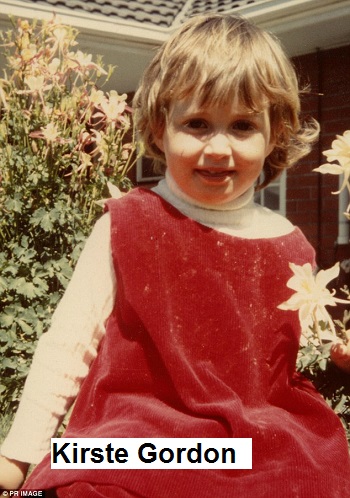
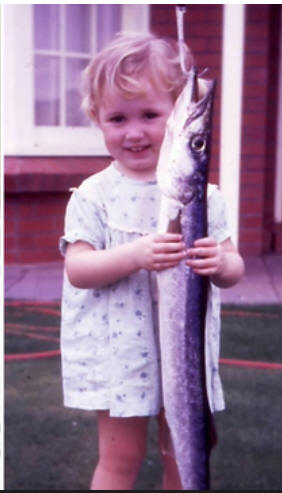
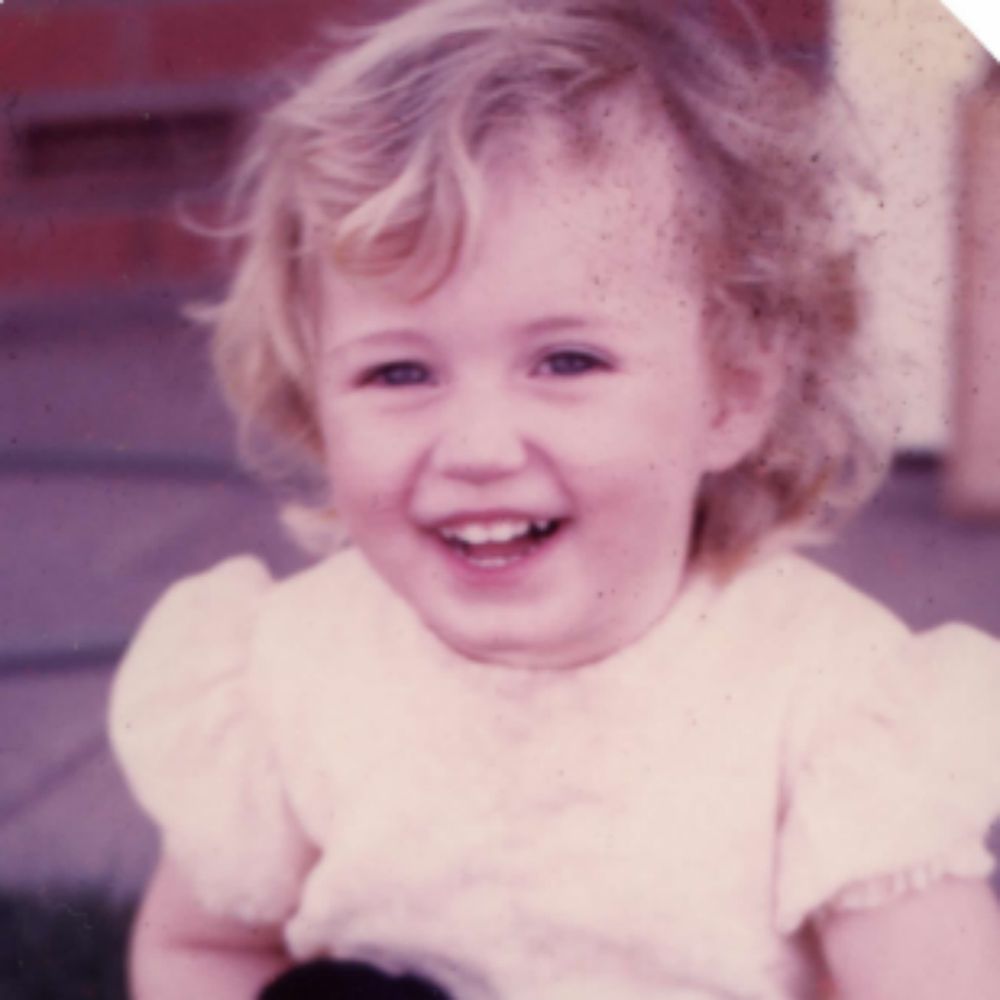
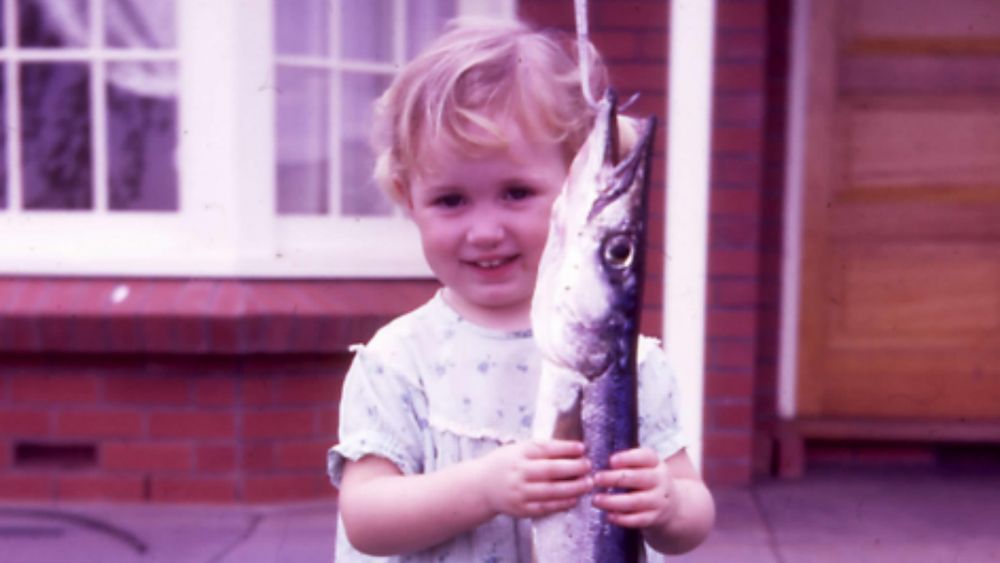
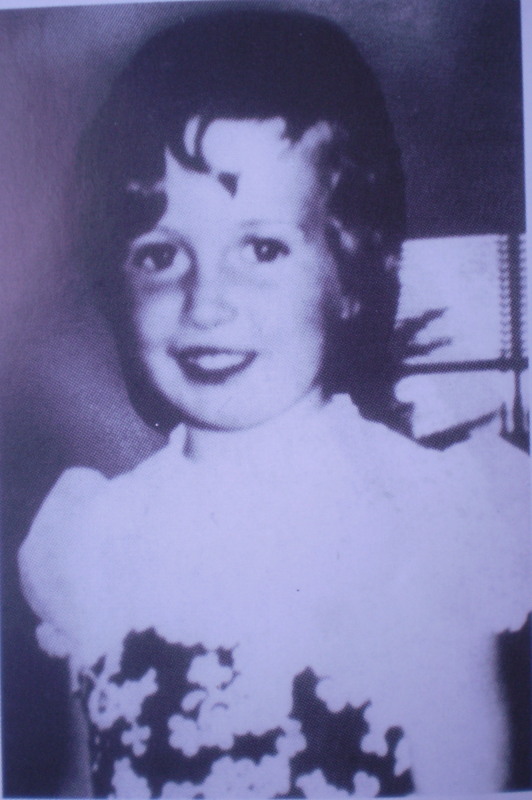
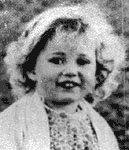

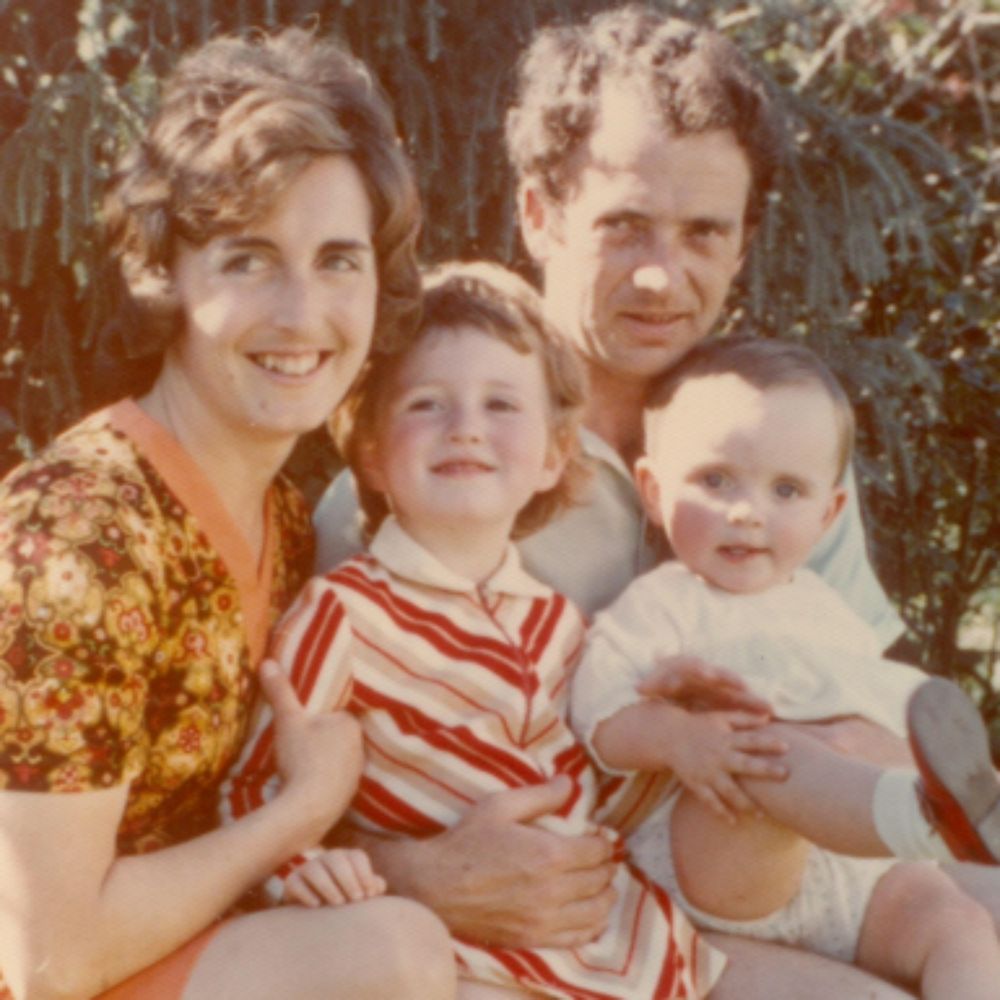
**Sketch on this page is the image of the man seen with the girls as they left the oval
Circumstances of Disappearance
On the 25th of August, 1973, a South Australian
National Football League game was in progress at Adelaide Oval. Joanne
Ratcliffe was at the match with her parents.
Kirste Gordon was there with
her grandmother. The two families had season tickets to the football and
always sat next to one another every week. When Joanne went to the toilet, Kirste Gordon's grandmother
asked her to take Kirste. They returned after a few minutes. A little over
half an hour later, Kirste again wanted to go to the toilet. Again, Joanne
took her, but this time they did not return.
Fifteen minutes later, after a discussion between the families they all went looking
for the girls, with most areas of the football stadium being searched and
Kirste's grandmother staying at the seats in case the girls found their way
back. The girls were not at the
toilet. Mr and Mrs Ratcliffe, and Kirste's grandmother, spent the rest of
the football match searching for the girls. The Assistant Curator of the
oval, Ken Wohling, saw the girls leaving the Oval with a man. Over the next
90 minutes, four different sightings of the man and the two girls were made.
In three of these sightings, Joanne appeared distressed. In one case a man
driving past went so far as to stop his car, but then decided that it was
none of his business, and drove on. Kirste Gordon and Joanne Ratcliffe were
seen with the man about 3 kilometres from the Oval, 90 minutes after they
had left it. This was the last sighting. Neither they nor the man were ever
seen nor heard from again.
In 1998, a joint inquiry was started to look into any possible connections
between the 1966 abductions of Jane, Arnna and Grant Beaumont, the
disappearance of Joanne Ratcliffe and Kirste Gordon.
Arthur Brown was arrested in 1998 for the murders of 2 young girls. Brown
closely resembles the suspect sketch in the disappearance of Joanne
Ratcliffe and Kirste Gordon. He also resembles the suspect sketch in the the
abductions of Jane, Arnna and Grant Beaumont.
Now no one will ever know if an old man called Arthur Stanley Brown was Australia's worst serial child killer. The retired Townsville carpenter, charged in 1998 with a notorious double murder - and suspected of others - has died, aged 90.
His death ends any chance of proving he was guilty, as police firmly believe he was, of the rape-murder of Mackay sisters Judith, 7, and Susan, 5, in Townsville in 1970.
But it also leaves unanswered questions hanging over other families robbed of their children.
Did Brown, subject of a Sunday Age investigation in July last year, abduct and kill other children over several decades - and not just in Queensland, where several cases remain unsolved?
Is it just a coincidence that he matched the descriptions of a thin-faced, middle-aged man who abducted Kirste Gordon and Joanne Ratcliffe from an Adelaide football game in August, 1973? Was he the same thin-faced man seen with the Beaumont children before they vanished from an Adelaide beach in 1966?
Brown not only took his secrets to the grave - he ensured his own death was kept quiet. He left instructions that no funeral notices be placed.
Only one of his second wife's daughters knows any details of his funeral, but when The Age reached her yesterday she wasn't talking. All that is known is that after his wife, Charlotte, died last April, he was put in a home at Malanda, north of Townsville. He died alone on July 6.
Brown has no known living blood relatives. His only kin are the children and grandchildren of two widowed sisters he married - the second one soon after the suspicious sudden death of the first.
Brown's name hit the headlines in 1998, after a woman broke a 30-year silence to tell police he had molested five children related to his first wife - often at the same spot where the Mackay sisters' bodies were found in 1970.
He had also owned a car in 1970 with one odd-coloured door, matching a description of one driven by the man who had abducted the Mackay girls. Relatives believe he replaced the door and buried it days after the murders.
Brown's first wife, Hester, crippled by arthritis, became a virtual prisoner in their neat fibro and timber house in Rosslea, an old suburb of Townsville. She died suddenly in May, 1978, from injuries Brown claimed she suffered in a fall.
Police believe the family doctor wrote out a death certificate without examining the body, which Brown had cremated immediately. Already close to Hester's younger sister Charlotte, a mother of five, he married her soon after.
Brown, a fit, wiry man, was unusually strong and obsessively neat, wearing pressed clothes to work as a maintenance carpenter on state government buildings. The Mackay sisters' clothes were found neatly folded near their bodies.
The evidence against Brown was strong but circumstantial. He twice blurted cryptic confessions to the Mackay girls' murders, once to a workmate and once to a stranger in a pub.
A Queensland jury could not reach a verdict in 1999, and a new trial was blocked on the ground that he was too senile to be tried again.
If Brown was a monster, what made him so? A stepson, Robert Neilsen, says Brown talked incessantly - but rarely mentioned children. "Except once, when the subject of little kids came up and he started to cry and said we had to look after the little children."
But Neilsen has no sympathy for the man his mother stuck with to the end of her life. "I can't believe such an insignificant little arsehole had such a profound effect on so many people's lives."
Sun Herald
Sunday July 8, 2001
THE disappearance of Judith Mackay, 7, and her sister Susan, 5, shocked the city of Townsville.
When their bodies were found in a creek bed on August 27, 1970 the day after they vanished on their way to school it was discovered they had been raped and stabbed in the chest.
Susan had been strangled. Judith choked from having her face rammed into the sand. It looked as if she had fled while her little sister was being killed, and was then run down.
Beside the bodies, their school uniforms were folded inside out and placed with an awful neatness. Their shoes, socks, hats and school bags were nearby.
A senior sergeant cried when he saw it.
Another policeman said he wouldn't go home until they caught the killer. He didn't, until he died of a heart attack two weeks later.
At 8.15am on the day the girls disappeared, road worker Bill Hankin noticed a man in a car with two girls in school uniforms; while everyone else was driving children towards the school ``like ants to a nest", this man was taking children away from it.
Hankin noted automatically that the driver was thin-featured, swarthy, not tall, and drove badly. He looked middle-aged, with a tanned complexion and dark wavy hair, cut short.
Neil Lunney, running late for work at the army barracks, was incensed when a car in front of him sped up and veered to block him when he tried to overtake.
Mr Lunney said: ``I did my cool. I was going to bumper roll him but, when I got up level with him, I saw the kids in the car." The older girl, on the passenger side, had shoulder-length hair, as Judith Mackay did.
The younger one, sitting in the middle, had shorter hair, like Susan Mackay. Both wore green Aitkenvale school uniforms.
Mr Lunney, a Vietnam veteran who had been taught recognition in the army, said the driver had high cheekbones, short hair, and ``Mickey Mouse" ears stuck out from a narrow skull.
Jean Thwaite was cleaning a car in the Shell service station she and her husband ran at Ayr, more than an hour's drive south-west of Townsville, when a car pulled up.
The car's petrol inlet was on the left side, and she had to open a flap to get at the screw-on cap, similar to her own 1965 EH Holden. This ruled out the car being a 1950s Holden but, unknown to her, was a design feature shared with the Vauxhall Victor, uncommon in country Queensland.
In the back seat, a small girl who looked as if she had been crying, asked: ``Are we there yet?" In the front seat was an older girl, who said to the driver: ``When are you taking us to mummy? You promised to take us to mummy."
Both wore green school uniforms.
Despite matching descriptions of the driver apart from his age there was no sketch or photofit picture of him published. Instead, the newspapers and television ran pictures of FJ Holdens, believed to be the model the man drove.
It put the investigation so far off course it never recovered.
In September 1970 trainee psychiatric nurse John White, 19, met a man called Arty Brown, a carpenter, in the bar of the White Horse Tavern in Charters Towers.
White guessed the man was perhaps in his 50s, but wiry and fit. He put his height at about 172cm and his weight at no more than 70kg.
He asked Mr White if he'd been following the murder of the Mackay sisters a few days before. Mr White nodded, and the man stated that the police, were ``looking for the wrong sort of car". Before Mr White could ask how he knew that, the man kept talking quickly. ``You know," he said, ``I killed those two girls."
Mr White alerted police who interviewed Mr Brown but found nothing suspicious.
In late March 1972, a cane farmer's teenage daughter, Marilyn Joy Wallman, vanished at Eimeo on the Queensland coast near Mackay.
The Wallman mystery was as brazen as Judith and Susan Mackay's abduction 20 months earlier, but with no clues. No cars. No suspects. No leads. Not even a body.
Then on August 26, 1973, the third anniversary of their girls' murder, Bill and Thelma Mackay, who had moved to Toowoomba, woke to the news two girls had been abducted from a football game in Adelaide. In a public place, in daylight, like the three Beaumont children seven years earlier in Adelaide, and their own girls and Marilyn Wallman.
Joanne Ratcliffe, 11, had taken Kirste Gordon, 4, to the women's lavatory, about 300m from the Adelaide Oval stand where her parents were sitting with Kirste's grandmother.
A teenager selling lollies, Anthony Kilmartin, saw a man lift the younger girl under his right arm and start walking fast. The older girl, whom he later identified from photographs as Joanne Ratcliffe, had looked frightened and tried to stop the man.
The older girl had kicked the man in the knee.
Sue Lawrie, her father and little sister heard the football siren as they left the zoo, about a kilometre from the oval on the other side of the Torrens River. Minutes later Sue, then 14, saw a middle-aged man hurrying towards them, carrying a small girl.
Behind him was a girl about 11, running to keep up, punching him in the back and yelling: ``We want to go back."
Merle Martin Moss was sitting alone in a flat in suburban Perth in October 1998, looking through her family ``birthday book" when a wave of revulsion hardened her resolve to unlock a terrible secret.
On the page under May was the name of an old man who, she knew, had molested at least five female relatives among her extended family.
After ringing police in Queensland, she poured out her story about an old man in Townsville called Arthur Brown. Ms Moss's younger sister Christine Millier and two cousins by marriage filled the gaps for police investigators in a horror story played out among three generations of apparently respectable folk.
In 1982 a tearful teenager told her parents Mr Brown had molested her as a small girl.
Arthur Stanley Brown was born at Merinda, near Bowen, on May 20, 1912. After spending several years in Melbourne he returned to Queensland and attached himself to the Anderson family.
Mr Brown was to marry two of the six Anderson sisters and was close to two others. He was first married in June 1944 to Hester, then freshly divorced, with three small children.
They lived an outwardly normal life for 34 years, but Hester's oldest sister Milly, now dead, told relations that Hester feared him, and had once confided to her: ``He doesn't just like big girls - he likes little girls too."
Hester, a virtual prisoner in the house Mr Brown had built in Rosslea, an old suburb of Townsville, died on May 15, 1978.
Mr Brown told the family doctor by telephone she had fallen while trying to get on the commode next to her bed, hitting her head and killing herself.
The doctor apparently wrote a death certificate at home without viewing the body, which Mr Brown took to an undertaker.
Hester Brown was cremated, which meant the injuries to her skull could never be examined. Hester's younger sister Charlotte moved in with Mr Brown and married him the following year.
The day the Mackay sisters were murdered, Christine Miller, 20, was staying at Mr Brown's.
The only unusual thing she remembers is that the radio, normally on, was switched off that night and next morning. She didn't hear news of the abduction until she reached Cairns the following evening.
Detectives came for Arthur Brown after breakfast on December 3, 1998.
When the officer in charge read the warrants, detailing allegations of murder and sexual abuse, the old man did not seem shocked. ``Didn't raise an eyebrow," one detective recalled.
When Mr White heard a man had been charged for the Mackay sisters' murder he told his partner: ``I bet his name is Arty Brown."
Sue Lawrie was living in Melbourne when she saw footage of an old man in Townsville on the television news.
The next day, talking to a friend in Adelaide, she screamed into the phone: ``My God! It's him." The man she'd seen on television was the same one she'd seen on the banks of the Torrens 25 years earlier.
Driving past Townsville police station in 1975 in Mr Brown's Vauxhall, John Hill, then a 16-year-old apprentice, had remarked that the police hadn't solved the Mackay sisters' murder.
Mr Brown replied: ``I know all about that. I did it."
MENTALLY UNFIT TO STAND TRIAL
Two charges of murder against Arthur Stanley Brown, 89, of Townsville, have been dropped. Queensland's Director of Public Prosecutions Leanne Clare said on Tuesday the charges would be discontinued because Mr Brown was mentally unfit to stand trial.
Mr Brown faced trial in October 1999 charged with the 1970 murders of Judith Mackay, 7, and her sister Susan, 5, but the jury was unable to agree on a verdict.
He was to be re-tried in July last year, but that decision sparked a year-long legal battle over his mental state which stretched to the Court of Appeal.
The Mental Health Tribunal found Mr Brown was unfit for trial a decision overturned on appeal by the Attorney-General over the tribunal's jurisdiction.
A psychiatrist hired by the DPP found Mr Brown had degenerative Alzheimer's disease and was unfit for trial.
LINKED IN DEATH
Susan Mackay
The five-year-old was abducted with her sister, Judith, and raped and murdered near Townsville on August 26, 1970.
Judith Mackay
The seven-year-old was raped and murdered with her sister, Susan. It appeared she fled while her sister was being killed, but was then run down.
Marilyn Joy Wallman
Marilyn, aged 14, vanished at Eimeo on the Queensland coast near Mackay on March 21, 1972.
Joanne Ratcliffe
The 11-year-old vanished at a football game at the Adelaide Oval, believed abducted, on August 26, 1973.
Kirste Gordon
The four-year-old was believed to have been abducted from the same football game as Joanne Ratcliffe.
Hester Brown
The wife of Arthur Brown, she died after hitting her head in a fall in her bedroom on May 15, 1978. Her body was cremated without a medical examination.
It also raises allegations which link the disappearance of the Beaumont children to the abduction of other children almost four decades ago.
Major Crime police have dismissed the claims in convicted paedophile Mark Trevor Marshall's 40-page hand-written document, saying they are his "sexual fantasies" and similar to material he has produced over the past four years.
Marshall, left, was, in 2009, jailed until further order by Justice Margaret Nyland, having been to prison at least six times since 1987 for sexual assaults on children.
Justice Nyland said he was "incapable of controlling his sexual instincts" but she then overturned her order.
Detective Senior Sergeant Paul Lewandowski of the Sexual Crimes Investigations Branch said the document by Marshall, which was submitted to the Mullighan Inquiry into abuse of children in state care in 2007, would be reviewed after The Advertiser passed it on to police.
However, police said that they would not investigate the claims further, having previously checked their validity.
In the document, Marshall writes graphic accounts of his involvement and presence as a young child at the River Torrens drowning of Adelaide University Professor George Duncan in 1972.
It also puts the young Marshall at the scene of the murder of girls Joanne Ratcliffe and Kirste Gordon, who were abducted from Adelaide Oval on August 25, 1973.
And it links his grandfather to the disappearance of the Beaumont children in 1966 and a string of sexual assaults.
It also outlines, with hand drawn maps and descriptions, where he believes the bodies of children he claims were murdered by his grandfather were buried.
Marshall's confession was anonymously sent to The Advertiser. The prison fellowship volunteer who sent it to Mr Mullighan has quit as an in-prison counsellor but is believed to still meet with Marshall. Efforts to contact him have been unsuccessful.
By Nicola Gage ABC
How do you cope when your child disappears in broad daylight and you never see them again?
It is a reality Greg and Christine Gordon have lived with for nearly 44 years, since their four-year-old daughter Kirste was snatched from Adelaide Oval during a football match.
Mr and Mrs Gordon were in South Australia's Riverland visiting friends when Mrs Gordon's mother, who was looking after Kirste, broke the news.
Kirste disappeared in August 1973, seven years after the three Beaumont children vanished from a beachside suburb in Adelaide.
She had walked to the oval's toilet with 11-year-old Joanne Ratcliffe, and they never came back.
Their disappearance is being highlighted as part of Missing Persons Week.
Despite the time that has passed, Mrs Gordon said the heartbreak still felt as raw as the day it happened.
"It was the longest day I think I've ever lived in my life," she said.
Without thinking, they jumped in the car for what Mrs Gordon described as one of the longest four-hour drives of her life.
"I really can't hear that song anymore."
Over the years there have been many leads, with reports that a man was seen taking the two girls from the oval.
Searches have also been conducted to find their remains but they have never been uncovered and no-one has been arrested.
Mrs Gordon said she did not know if finding Kirste's remains would make her feel any different about never seeing her daughter again.
"What is closure? Do you need to have a body? Do you need to have a funeral? Do you need to bring her home?
Each year 38,000 people around Australia go missing and two-thirds are under the age of 18.
Assistant Commissioner Debbie Platt said they were predominantly female and aged between 13 and 17.
While most are located in the first week, other families, like the Gordons, can go for years without hearing from them.
"When someone goes missing it causes a great deal of frustration, angst and worry for many family and friends," Assistant Commissioner Platt said.
"Any information that the community can give us, particularly in Missing Persons Week, is vital.
"We will continue to have people on our books until they are located."
Australian Federal Police victim-based crime national coordinator Marina Simoncini said the impact on families of missing persons could be devastating.
"They have no idea what has happened to someone they love," she said.
"When there's a death in the family there's some finality to it.
Fifty-four years ago Australia lost its innocence with the kidnapping of the Beaumont children – now we may know what happened.
Fifty-four years ago today, Australia lost its innocence, on what was meant to be a day of celebration.
Jane, Arnna, and Grant Beaumont, aged nine, seven and four, respectively, were lured from Glenelg Beach in Adelaide by an unknown assailant.
Like they had many times before, they caught the bus to the beach unsupervised, with sensible Jane Beaumont tasked with ensuring the younger children’s safety.
Such an arrangement may seem akin to child neglect today, but it wasn’t uncommon in 1966. The bus trip was only five minutes, Australia was regarded as a safe place to raise children, and many kids in neighbourhoods across the country enjoyed a free range upbringing.
The disappearance of the Beaumont children and the widespread coverage it received changed all that. Stranger danger was the new normal, and tight communities eyed each other nervously, former neighbours now potential suspects. The Australian way of life had forever changed.
Despite the story of the Beaumont children remaining in the country’s collective consciousness for more than half a century, the three children have never been found, and the identity of the 30-something slim man who was spotted with the children that day by numerous onlookers remains a mystery.
Two strikingly similar child abductions that occurred around the same time may be the key to solving this harrowing crime.
HIDING IN PLAIN SIGHT
Adelaide Oval was packed for the August 25, 1973 Aussie rules match between Norwood and North Adelaide.
Joanne Ratcliffe, 11, was one of 13,000 spectators who attended the football match. She was sitting with her parents and next to Kirste Gordon, a four-year-old who was in the care of her grandmother. Joanne’s family had been to the oval to watch dozens of games, and the young girl knew her way around the grounds. Bored, she struck up a friendship with the four-year-old sitting next to her, and when the younger child asked to go to the bathroom, Joanne volunteered to take her.
The Ratcliffe family had a rule: Joanne could go to the bathroom while the game was being played but not during the last quarter, nor in any of the breaks. The two girls went together early in the game and then again during the third quarter. The second time, they did not return.
A skinny-faced man around the age of 40, wearing a brimmed hat and a tweed jacket, was spotted with the girls in and around the oval by numerous witnesses.
The assistant curator of Adelaide Oval, Ken Wohling, spotted the man and the two young girls behind the grandstand trying to coax a kitten out from under a car.
Anthony Kilmartin, 13, was selling drinks and lollies when he saw the man come from behind a tree and “scoop up” the younger girl with one arm and carry her towards the southern gates, with Joanne following frantically behind.
According to Anthony, Joanne, who he later identified from a selection of photographs, was kicking the man in the shins and pulling at his jacket. He was angrily yelling “clear off” before taking her by the arm and leading both children out the gates.
Sue Laurie, just one year older than Anthony, witnessed the same scene but mistakenly read this as a family dispute. This misinterpretation was understandable, and even after learning of the abductions, she didn’t make the link. It wasn’t until 1980, when she offhandedly mentioned the scene to her husband, that it began to weigh heavily on her mind. She reported it to police but didn’t revisit this day again in her mind until almost two decades later.
“The child was crying,” she told Adelaide radio station 5AA in 1998, “and a second girl who looked a few years younger than me was running after the man, thumping him and punching into him and shouting, ‘We want to go back’.
“I assumed, absolutely assumed, that the man must be the girls’ grandfather and that the girls were misbehaving. I watched it all for about 60 seconds, and my main reaction was surprise that the grandfather didn’t tell his granddaughter off for hitting him.”
Ninety minutes later a motorist spotted the trio some three kilometres past the oval, and such was Joanne’s distress, the man pulled over before thinking twice about interfering. This was the last reported sighting of the two girls or the man.
Given the man’s distinct appearance, and how he was acting in broad daylight, in an oval containing 13,000 people, police were able to get an accurate description.
The identikit picture was drawn and widely disseminated and an eerie connection was apparent to all.
The police sketch of the suspect in the Adelaide Oval case looked exactly the same as the one drawn years earlier after the Beaumont children went missing.
THE MACKAY MURDERS
Judith and Susan Mackay, aged seven and five, were only 200 metres from their house in Townsville when they were abducted. They had only left home 10 minutes earlier, strolling up to the bus stop to head to school.
Their naked bodies were discovered two days later in a dry creek bed. Both girls had been raped, and each had been stabbed three times in the chest. Both of them were choked to death before the sexual assaults took place: Susan with the killer’s bare hands, and Judith after sand was forced into her mouth and nose, blocking her airways.
With chilling precision, their school uniforms were neatly folded and placed beside them, along with their straw hats and school bags. Even their socks were folded and placed carefully, one inside each little shoe.
As with the Adelaide Oval case and the Beaumont children disappearance, there were plenty of witnesses. One man saw a slender male leaning out of a car, talking to the girls at the bus stop, at 8.10am. Three hours later, and 85 kilometres away, the same man pulled up at a service station and refuelled. The attendant, Jean Thwaite, recalled later that one of the two girls with the man asked, “When are you taking us to mummy? You promised to take us to mummy.” The two children seemed upset.
Later still, another driver had a heated argument with the man, who was with two young girls in school uniforms that matched those of the Mackay girls.
Although these latter two sightings were the most concrete, they were disregarded by police, as both the petrol station attendant and motorist claimed the car was a Vauxhall with a mismatched driver’s side door. They also both gave similar descriptions of a man with a narrow, long head and high cheekbones.
Police were told by numerous other witnesses, however, that the car was an FJ Holden with a mismatched door, and given this description happened to match a car parked near where the bodies were found, police focused on finding this vehicle above all else. A police sketch was never circulated to media, as the car was thought to be the salient piece of information.
The FJ Holden was never located, vital witness statements were not treated seriously, and the case quickly went cold.
Eighteen years later, while watching a TV report on the case, Sue Laurie sat up with a start. She recognised the man who was being charged with the Mackay murders. It was the same man she had seen a quarter of a century earlier, the “grandfather” who was being hit by a distressed young girl as he steered two children out of Adelaide Oval.
ARTHUR STANLEY BROWN
On July 6, 2002, Arthur Stanley Brown slipped away for the final time, aged 90. He died alone, in a nursing home in Malanda, Queensland. He left no blood relatives and gave instructions to his carer that there were to be no death notices published. It took months for the media to report on his death.
Brown died an innocent man, having never been convicted of any of the crimes he was charged with, including the rape of six children, the Mackay murder and 45 sexual assault charges.
Photos of him taken in the 1970s and in his later life look shockingly similar to the identikit police sketches from the Adelaide Oval murders. His appearance remained consistent throughout his adult life, giving witness sightings from decades ago a vivid quality.
From all accounts, Brown was a very strange man. He was meticulously neat to a fault, with immaculately pressed shirts, and an odd habit of folding garbage up into near squares before disposing of it. This latter quality interested police, given the neatly folded clothing near the Mackay sisters’ bodies. He also drove a Vauxhall with an oddly coloured door, which he replaced and buried shortly after the murders as he didn’t want “anyone interviewing or annoying him”.
Brown married Hester Porter in 1944 and became stepfather to her three children while also conducting an affair with Hester’s sister Charlotte. When Hester died in 1978 following a fall, he quickly married Charlotte. Charlotte’s son, Peter Neilsen, believes Brown actually killed his first wife, fearing she was planning to go to the police.
Hester had caught Brown molesting a child and confessed to her older sister Milly that she made sure he was never alone with her children. It wasn’t enough to protect them.
As various relatives came forward in the early 1980s and claimed that Brown had molested them as children, they teamed up and sought legal advice. Sadly, they were advised to keep this a family secret for fear that a trial may be traumatic for Brown’s many victims. Many of the children were taken by Brown to the same dry creek bed the Mackay sisters were found in.
Brown lived in Queensland all his life and repeatedly denied he was in Adelaide around the time of the Ratcliffe/Gordon disappearance. He once betrayed this in a conversation with Mim Moss, a relative through marriage. Brown was talking to Moss and her sister, who had just returned from Adelaide. He mentioned he visited Festival Hall not long after it opened – which would place him in the area in 1973.
Moss also claimed Brown was obsessed with the Mackay sisters’ killings, as he worked as a carpenter at their school.
“He asked aunty Hester, my sister and I if we wanted to go out and see where the Mackay girls were murdered,” Ms Moss said.
“It would have only been a couple of weeks after they were found.’’
Brown also had a secret room in his house that locked on the inside.
“Aunty Hester and I got in there one day and found bottles of port wine and all these books, true stories on women who had been murdered, absolutely slaughtered,” she said.
“He used to get all the grandkids drunk and show them the pictures of women who had been gutted and say, ‘Look, isn’t that wonderful?’ There was paraphernalia like ropes and stuff like that.’’
BROWN CHARGED BUT NOT CONVICTED
A 1998 crime special led to Brown’s arrest. The program focused on the 1970 murder of the Mackay sisters and prompted one of Hester’s cousins, who was molested by Brown and long suspected him of the murders, to call Crimestoppers.
She reported that Brown had molested several of his relatives and shared her suspicions of the Mackay murders. Police cast a wide net and located two men who claimed Brown confessed to the murders, although neither took him seriously at the time.
The motorist who argued with the man on the day of the Mackay abduction and the petrol station attendant who saw the upset girls in his car both positively identified Brown as the man they saw in 1970.
The evidence against Brown was circumstantial, and a Supreme Court jury was unable to decide upon a verdict.
A retrial was scheduled, but Brown’s wife Charlotte fronted the Mental Health Tribunal and claimed that he was unfit to stand trial due to his increasing dementia. Brown was diagnosed with Alzheimer’s, and the prosecution dropped the charges, believing it pointless to continue.
Arthur Stanley Brown died in 2002, with a clean criminal record. Members of his own family believe he may have been responsible for at least nine murders.
The Mackay case is officially closed, with police satisfied that Brown was the killer, but both the Adelaide Oval abductions and the location of the Beaumont children remain a mystery.
On the 47th anniversary of the abduction of girls Joanne Ratcliffe and Kirste Gordon from Adelaide Oval, a new DNA-matching program may hold the answer for their long-suffering families.
The Australian Federal Police this month launched a national DNA program for unidentified, missing persons to allow advanced DNA profiling and matching of unidentified human remains from missing persons for the first time.
Project lead, associate professor Jodie Ward, said up to 500 sets of remains would be examined with modern forensic techniques to fill gaps in Australia’s national missing persons databases.
In the event there are no DNA matches, the new technology will be used to predict the ancestry, eye and hair colour or distant relatives of the unknown individual to assist with linking them to a missing person.
The AFP’s National Missing Persons Coordination Centre will work with police and families of missing people to collect reference DNA samples to assist with filling gaps.
“My goal is to identify some of these deceased people and provide answers to families with missing loved ones, and we have the science to do that,” Dr Ward said.
“The legacy of this program is that we have... more streamlined forensic approaches for missing persons investigations going forward.”
Multiple properties in South Australia’s Mid North have been searched for Joanne and Kirste’s remains, but after 47 years, Ms Ratcliffe has not buried her sister. A sketch of a suspect has been drawn and a $1 million reward is offered for anyone who provides information that leads to a conviction.
Her brother, David Ratcliffe, sadly passed away in April from a heart attack at age 59 – leaving Ms Ratcliffe as the only remaining immediate family member in need of answers.
“He and Joanne were thick as thieves and I know over the years it had tortured him, he blamed himself a lot for not being there and not being able to protect the girls on the day they were taken.”
She said the prospect of identifying Joanne’s remains would bring her brother, mother, and father peace from the grave.
The unidentified human remains of about 500 people have been found in Australia, with the new program aiming to give closure to families after years of searching.
“This new technology and this new program, that’s a huge light for families, knowing it could possibly lead to them finally being reunited with their loved ones.
“We just want to bring Joanne and Kirste home so we can bury them with the love and respect they deserve.”
In 2015 Ms Ratcliffe formed the Leave a Light On Foundation to raise awareness for long-term missing persons and connect a community experiencing loss.
The organisation was named after Ms Ratcliffe’s mother left the light of their Campbelltown property for years following Joanne’s disappearance – in case she returned home.
Ms Ratcliffe remains in contact with Kirste’s family through a victim support officer, and has communicated with more than 150 families of missing persons to alert them of the new DNA program.
Her daughter, Tamara, 14, was given her middle name after Joanne.
“(Tamara) looks very much like her Aunty Joanne, and who has the same sort of fiery temper, but also the same caring and loving nature.”
Every year Ms Ratcliffe and Tamara go to Woolshed Falls near Beechworth in Victoria to throw flowers down the falls on Joanne’s anniversary on August 25.
Due to COVID-19 restrictions, the pair will this year burn a candle in her honour.